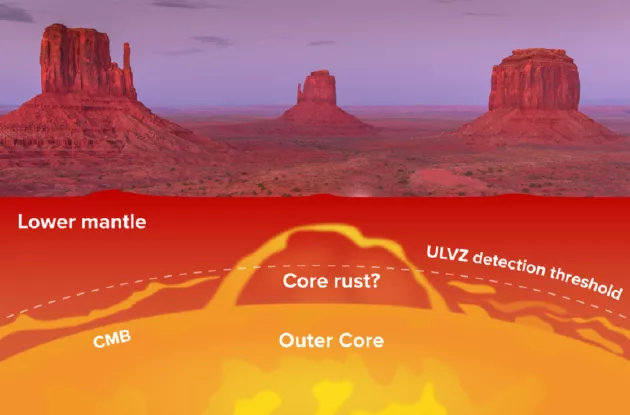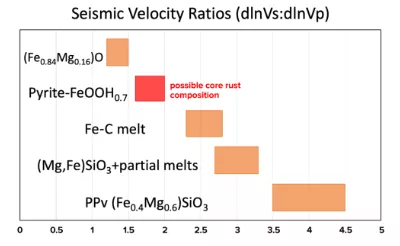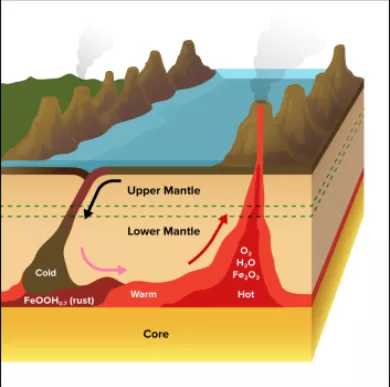Owl rock in Monument Valley, Arizona, USA. The red color of the rock comes from iron oxide minerals. Recent experiments have shown that iron oxides may also form below the earth's surface, even as deep as the junction between the earth's core and the lower mantle. When the subduction zone carries water bearing minerals deep into the mantle, it may "rust" the earth's iron outer core and form a huge oxygen sink. After that, the oxygen will return to the atmosphere.
Iron on the earth's surface, whether simple nails or solid beams, will gradually oxidize when exposed to humid air or oxygenated water. The reddish brown product of this reaction is rust, which can be composed of various forms of aqueous iron oxide and iron oxide hydroxide. The red rocks found in the arid climate area of the southwestern United States and many other places belong to the same iron oxide mineral - hematite; In humid environment, iron ores such as hematite will be weathered into iron basic oxide - goethite (FeOOH).
Deep in the earth, to be exact, 2900 kilometers below the earth's surface, a large amount of molten iron forms the earth's outer core. So, will the outer core rust?
Recently, scientists have found in experiments that when iron meets with water - in the form of water or hydroxyl containing minerals - at a pressure of nearly 1 million atmospheres (similar to the depth of the mantle), it will form iron peroxide or iron oxide iron hydroxide in the form of high pressure, with the same structure as pyrite (known as pyrite FeOOH). In other words, the oxidation reactions in these experiments do form high-pressure rust.
Scientists' view of the boundary between the mantle and the outer core (CMB for short) may be necessary, if it does exist at the boundary between the mantle and the outer core. These rust can reveal the deep-water circulation of the lower mantle and the mysterious origin of ultra-low velocity regions (ulvzs). The ultra-low velocity region is a small and thin layer (no more than 50km) above the earth's fluid core, where the seismic wave velocity decreases significantly. These rust may also explain the large oxidation event (goe) and Neoproterozoic oxidation event (NOE). The former marked the beginning of the earth's oxygen rich atmosphere, which occurred about 2.5 billion to 2.3 billion years ago; The latter occurred 1 billion to 540 million years ago, bringing the free oxygen in the atmosphere to the current level.
But how do we know if the Gutenberg interface has rusted?

The red rocks on the earth's surface mainly come from oxidized hematite and goethite. The possible rust deposits at the core mantle boundary (Gutenberg interface) below 2900 km of the earth's surface may be composed of iron oxide iron hydroxide minerals with pyrite like structure. This rust material can explain the ultra-low velocity zone (ulvz) found in seismic data. The detection threshold of ultra-low velocity region reflects the resolution of current seismic section scanning.
Seismic characteristics of the core mantle junction
Although it is not possible to mine minerals under the Gutenberg interface at present, we can detect them by other methods. If the core will rust over time, a layer of rust may have accumulated on the Gutenberg interface, which can show some seismic characteristics.
Laboratory studies have shown that iron oxide iron hydroxide rust in the earth's core (i.e. feoohx, where x is a value of 0 to 1) may lead to a significant reduction in the velocity of seismic shear wave (VS) and longitudinal wave (VP) passing through it, just like rock (or partial melting) in ultra-low velocity zone. In fact, compared with the average seismic wave velocity as a function of depth in the preliminary reference earth model, the core rust can reduce the shear and longitudinal wave velocities by 44% and 23% respectively. If the thickness of rust accumulation in the earth's core exceeds 3 to 5 kilometers, the huge seismic wave deceleration will enable it to be identified in seismic tomography.
The difficulty is to distinguish whether the seismic anomaly in the ultra-low speed area is caused by the rust of the earth's core or other reasons. For example, it is generally believed that the partial melting at the bottom of the lower mantle is the cause of the ultra-low velocity region, which may also lead to the reduction of seismic wave velocity similar to that caused by core rust.
In theory, scientists should be able to use seismic tomography to distinguish between core rust and partial melting at the Gutenberg interface. Seismic tomography is usually generated by mathematical inversion process, which matches the calculated seismic waveform with the observed waveform. The inversion process needs to determine the possible mathematical solutions of the fitted data, and then select a "best" solution from these solutions according to other considerations.
Each possible mathematical solution corresponds to a set of model parameters related to the physical properties of the material involved, but with obvious differences, such as the relative differences of S-wave, P-wave and density of rust material, as well as the average value of the mantle around the material.
These differences may vary with the content of materials in the mantle, but each material usually shows the eigenvalue range of the differential logarithm ratio of shear wave to longitudinal wave( δ lnVs: δ Lnvp), which can be used to distinguish different materials in seismic tomography. According to mineral physics experiments, for all materials that may explain the source of ultra-low velocity region, the lower limit of the ratio is 1.2:1 and the upper limit is 4.5:1. In this range, the ratio of core rust (pyrite feoohx) is between 1.6:1 and 2:1, which is different from other materials.

Range of seismic wave velocity ratio of different materials
Evidence of the origin of rust
So far, seismologists have sampled 60% of the Gutenberg interface to find the ultra-low velocity region, and have determined nearly 50 abnormal locations of seismic waves, accounting for 20% of the Gutenberg interface region, which may represent the ultra-low velocity region. Most of these regions are coupled with large and low shear velocity provinces (llsvps) at the bottom of the mantle, δ lnVs: δ Lnvp is about 3:1, indicating partial melting.
However, some of them are located at the edge or outside of llsvp below the Pacific Ocean, and the best fitting ratio is about 2:1. For example, an ultra-low velocity region located at the northern boundary of llsvp in the Pacific Ocean (about 9 degrees north latitude and 151 degrees west longitude) and a group of ultra-low velocity regions below northern Mexico (about 24 degrees north latitude and 104 degrees west longitude) have detected the existence of pyrite feoohx δ lnVs: δ Lnvp ratio.
A common feature of these ultra-low velocity regions is that they are located in a relatively low temperature region on the Gutenberg interface, which is hundreds of Kelvin lower than the average temperature in llsvp. Low temperature indicates that these regions are not produced by melting mechanism. It is worth noting that scientists have determined that the area below northern Mexico is composed of deep subduction relics deposited in North America and Western Central America about 200 million years ago, suggesting that the water released from the subduction plate may have corroded the outer core at the Gutenberg interface.
Consequences of rust in the earth's core
Scientists believe that the main mineral in the earth's lower mantle, bridgmanite, has little ability to store water. However, the corrosion of the earth's core may form a large reservoir at the Gutenberg interface - feoohx rust may contain about 7% water by weight. Because the core rust is heavier on average than the mantle, this reservoir tends to stay at the Gutenberg interface. Therefore, in theory, water can be transported and stored outside the earth's core, at least until mantle convection takes it away from the colder areas near the remains of subducted plates and makes it thermally unstable.
Geological, isotopic and chemical evidence shows that most or all of the earth's atmosphere was anoxic during the Archean. Molecular oxygen first entered the atmosphere after the Archean, during the great oxidation event about 2.4 billion years ago. The second major rise of oxygen content in the atmosphere was the Neoproterozoic oxidation event, which occurred about 750 million years ago, making its concentration close to today's level.
Scientists are still uncertain about the reasons behind these oxidation events. One possible explanation for the great oxidation event is the emergence of cyanobacteria, which are the early pioneers of plant photosynthesis. The Neoproterozoic oxidation event that occurred nearly 2 billion years later is attributed to the rapid increase of marine photosynthesis and the growth of Photoperiod (i.e. longer sunshine time).
However, these explanations are far from impeccable. For example, in addition to the mismatch between the time of the large oxidation event and the occurrence of cyanobacteria on earth, several studies have shown that the oxygen in the atmosphere may drop sharply to a lower level after a large increase at the beginning of the large oxidation event and last for millions of years. So far, there is no convincing evidence based on the explanation of cyanobacteria photosynthesis.
In addition, although scientists generally believe that the oxygen concentration in the atmosphere increased only slightly during the large oxidation event compared with that during the Neoproterozoic oxidation event, in laboratory research, they obtained a contradictory result by analyzing the effect of photoperiod on the net oxygen output of microbial mat, whose photosynthetic community and chemosynthetic community are competitive. During the Neoproterozoic oxidation event, longer sunshine did not cause these microbial mats to produce more oxygen; Experiments show that during the Neoproterozoic oxidation event, the increase of oxygen caused by the increase of day length (from 21 hours to 24 hours) may be only half of that during the large oxidation event (the increase of day length to 21 hours).
Therefore, the changes attributed to cyanobacteria and photoperiod length cannot provide a complete or consistent explanation for the increase of atmospheric oxygen content during large oxidation events or Neoproterozoic oxidation events, and we cannot exclude other mechanisms of the origin of these events.

The core rust (feooh0.7) may be formed when the relatively low-temperature subduction plate carrying water bearing minerals meets the outer core. Under the action of mantle convection, the rust flowing out of the low-temperature region will migrate along the core mantle boundary to the hotter region at the root of the mantle plume, where it becomes unstable and decomposes into hematite, water and oxygen
Subduction, migration, convection and eruption
For decades, researchers have been unable to find conclusive evidence to prove when the earth's plate tectonics began. However, some recent studies show that subduction began to bring water bearing minerals deep into the mantle 3.3 billion years ago. Experimental studies show that water bearing minerals in subducted plates can transport water all the way to the Gutenberg interface. If so, the first ancient rock plate may have corroded when it came into contact with the earth's core. The core rust may gradually accumulate in the Gutenberg interface, forming an ultra-low velocity region. Driven by mantle convection, this pile of rust migrates from the colder subduction region at the top of the molten outer core and begins to heat up gradually. When it reaches the hotter region where the mantle plume takes root, it may become very unstable.
Just as typical volcanic eruptions occur intermittently, temperature driven decomposition of core rust may lead to intermittent eruptions of surface oxygen. Compared with the gradual increase of oxygen in cyanobacteria photosynthesis, such an explosion may release oxygen much faster than the reaction and consumption of the surface environment, resulting in the rapid rise of atmospheric oxygen level at first and then decline.
Compared with the duration of surface magmatic eruption, the accumulation and migration of large rust piles to thermal decomposition sites may take longer. In fact, some formed rust piles may not have reached the temperature enough to cause decomposition, and the negative buoyancy of the deep mantle around them will keep them below the Gutenberg interface. Geological records show that the earth's surface was completely covered by oceans until 3.2 billion years ago. The net removal of water from the earth's surface and its storage in the form of core rust in the deep mantle may have contributed to the emergence of Archean continents, although surface and topographic changes driven by plate tectonics and the growth of buoyant continents also contributed to it.
Potential paradigm shift
Each of us can see that the iron on the earth's surface will rust, but unfortunately, no one can directly prove that similar corrosion will occur in the liquid iron core below 2900 kilometers on the earth's surface. However, continuous research will help to eliminate all kinds of uncertainties and answer some key questions, such as whether nuclear rust is related to large-scale oxidation events and Neoproterozoic oxidation events.
In particular, we need more laboratory experiments to accurately determine the thermal stability and compositional stability limits of nuclear rust when it reaches equilibrium with molten iron at the Gutenberg interface. For example, we need to study the balance between core rust and liquid iron under high pressure and high temperature. Other studies can test the thermal stability of rust under high pressure. These experiments are very challenging, but as far as the experimental ability of laser heated diamond on anvil is concerned, it is feasible.
In addition, we need to do additional work to determine when the subduction begins, especially when the "wet subduction" begins, that is, the water bearing minerals are brought deep into the earth's interior. Geochemical evidence suggests that wet subduction did not begin until 2.25 billion years ago, rather than 3.3 billion years ago. The wet subduction that began so late may challenge the hypothesis that core rust is the origin of the great oxidation event.
In addition, whether mantle convection involves layered circulation (separate convection units in the upper and lower mantle), whole mantle circulation or some mixed form of the two still needs to be clarified. If layered circulation prevails in the mantle, subducted plates will not be able to enter the lower mantle. Therefore, whether it is the whole mantle or mixed convection, the subducted plate and its water bearing minerals must exist in order to reach the Gutenberg interface and lead to potential outer core rust.
If we can piece together a complete puzzle, the rust in the outer core may indeed be a huge internal oxygen generator on earth - perhaps the next major atmospheric oxidation event is about to happen. Such events may cause a variety of problems, including the impact on the future environment, climate and habitability. In the short term, the recognition of the outer nuclear rust of the earth will change our understanding of the deep interior of the earth and predict how the deep interior of the earth will fundamentally affect the environment and life activities on the earth's surface.